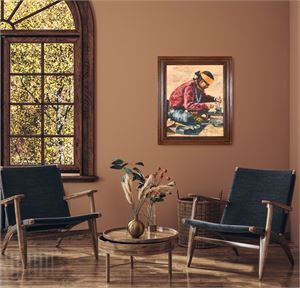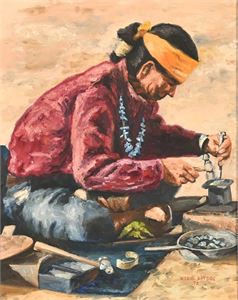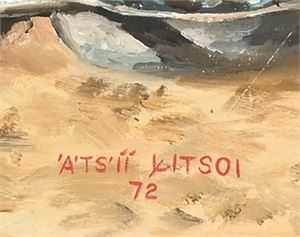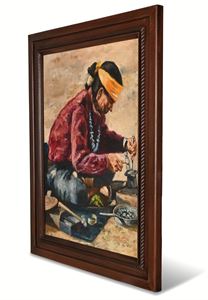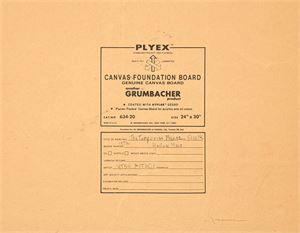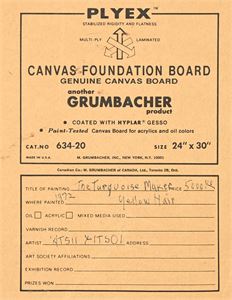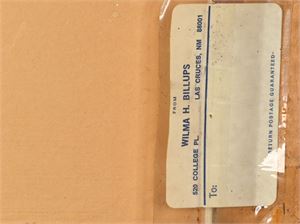The Turquoise Maker, Jimmy Yellowhair (Diné/Navajo) View Watchlist >
Seller Accepts Credit Cards
Payment and pickup instructions will be available on your invoice (under "My Account") at the conclusion of this auction.
Lot # M236
System ID # 23882222
Start Date
End Date
5 Watching
The Turquoise Maker, Jimmy Yellowhair (Diné/Navajo)
Jimmy Yellowhair (Diné/Navajo, active 1960s–)
The Turquoise Maker, 1972
Oil on Grumbacher “Plyex” canvas board
Image: 28 ½ x 23 in. | Frame: 36 x 30 in.
Signed lower right in Navajo syllabary ‘Ats’ííʼ Łitsoi (“Yellowhair”).
This commanding oil painting by Jimmy Yellowhair, a distinguished Diné painter, depicts a Navajo silversmith at work, tools and crucible arrayed before him as he fashions turquoise jewelry. The sitter’s yellow headband and turquoise bead necklace serve as powerful emblems of identity, while the artist’s vigorous brushwork and warm desert tones ground the composition in the cultural landscape of the Southwest.
Yellowhair’s works typically bear his English signature; here, the use of his Navajo name—‘Ats’ííʼ Łitsoi—is both rare and culturally significant. Accompanied by original inscriptions on the verso, including the title, date, and early price notation, as well as a provenance label from Las Cruces, New Mexico.
Large oils of this scale are seldom encountered in the artist’s oeuvre, most known for smaller acrylics. The Turquoise Maker stands as a vivid homage to Diné artisanship and is a significant opportunity for the serious collector of Native American art.
Condition
In good condition overall. The painted surface is stable and free of losses; colors remain vibrant. The board lies flat. Frame with light surface wear consistent with age.
Artist Biography
Jimmy Yellowhair (Diné/Navajo, active from the 1960s–)
Jimmy Yellowhair, known in his Navajo language as ‘Ats’ííʼ Łitsoi (“Yellowhair”), is a Diné painter whose work is deeply rooted in the traditions and daily life of his people. Born into the Navajo Nation, Yellowhair has lived much of his life in Houck, Arizona, where he continues to reside in a traditional hogan. This connection to the land and community informs his art, which reflects both the spiritual and practical rhythms of Navajo culture.
Yellowhair emerged as an artist in the 1960s and soon became known for his vivid depictions of Diné ceremonies, artisans at work, kachina figures, and still lifes. His paintings are characterized by bold, direct brushwork and a palette that mirrors the desert landscape—sandy earth tones punctuated by vibrant reds, yellows, and turquoise blues. Central to his practice is a deep respect for Navajo artisanship, often portraying silversmiths, potters, and weavers, thereby honoring the creative traditions that sustain Diné identity.
His works have been exhibited widely, including at the Gambaro Museum in Washington, D.C., the Mid-America Arts Center in Wichita, Kansas, and galleries in London, England, reflecting the international reach of his vision. While his paintings were long available through trading posts and regional galleries, his recognition has steadily grown, and examples of his work now circulate regularly in the auction market. Most paintings bear his English name signature, though on rare occasions—as with The Turquoise Maker (1972)—he signed in Navajo as ‘Ats’ííʼ Łitsoi, underscoring both personal identity and cultural heritage.
Yellowhair’s paintings are more than artistic statements; they are visual testaments to Navajo life in the modern era, bridging tradition and contemporaneity. Through them, he has preserved moments of artisanship, ceremony, and daily existence, offering collectors and institutions works of both aesthetic and cultural resonance.


